 Thanks: 0
Thanks: 0
 Needs Pictures: 0
Needs Pictures: 0
 Picture(s) thanks: 0
Picture(s) thanks: 0
Results 1 to 14 of 14
Thread: Using dubbin to finish timber
-
17th December 2013, 11:47 PM #1
 Member
Member











- Join Date
- Apr 2013
- Location
- Brisbane
- Posts
- 61
 Using dubbin to finish timber
Using dubbin to finish timber
Hi guys, this may sound like a ridiculous question. However I was wondering if anybody has ever used dubbin to finish timber. I heard about a guy in the states that routinely uses beeswax shoe polish and swears by the results. Thought maybe dubbin might be an idea as I have three tins in the bottom drawer. All feedback for my crazy idea welcome.
-
17th December 2013 11:47 PM # ADSGoogle Adsense Advertisement
- Join Date
- Always
- Location
- Advertising world
- Posts
- Many
-
18th December 2013, 01:35 AM #2
 Banned
Banned











- Join Date
- Jul 2013
- Location
- Perth
- Posts
- 665
 If
If
If you apply enough heat thru friction to it, it will get a bit of a shine - but not a very hard or lustrous shine.
I've used bees wax - its a nice natural product but in its dubbin formulation is more suited to leather - where it penetrates and remains supple to move with the leather. I also have a couple tins of it and use it on my leather chair seats, while I use Gillie Stephenson's orange oil on the Jarrah chair frames. That said the Gillie Stephenson's orange oil has a small %age of bees wax in it.
There are other waxes better suited to use on timber - ones that harden and shine more (carnuba / canuba) springs to mind if you want something that will harden and shine and be a little more resistant to wear.
Others mileage will vary - everyone has their own super secret finish protocols and products.
You can always try it on a piece of scrap first!
-
18th December 2013, 08:02 AM #3
 Member
Member











- Join Date
- Apr 2013
- Location
- Brisbane
- Posts
- 61
-
18th December 2013, 03:09 PM #4
 Banned
Banned











- Join Date
- Jul 2013
- Location
- Perth
- Posts
- 665
 Now
Now
Now i think of it - Gillie Stephensons make a tin not unlike your dubbin one there - with just bees wax in it.
I used it once on a suite of solid hardwood timber desks for a naval architect mate of mine.
I oiled the timber with orange oil several times (flooded it in essence) until it wouldn't take up any more over a couple days...wiped off the excess, and then when dry to the touch I used a sheeps wool buff normally used on cars, with a polisher and bees wax from Gillie Stephensons.
The finnish was beautiful and lasted well enough for a couple years.
However.
The work room they were in wasn't always air conditioned - if my mate wasn't actually working in it... so being semi retired from naval architecture and having a couple horse farms he spends time out of the house a lot in summer harvesting hay for eg.
The room with the desks gets pretty hot... in summer when the air cons not switched on.
What I noticed was that the wax had melted on the actual working surface top - where he sat and worked - from his forearms resting on the desk and the heat.
It was dirty - dark thick and not pleasant to look at any longer.
In essence it had to be scraped off and re oiled and waxed again...
Probably for a high traffic work area like a desk top a more durable finish might have been a better choice.
On vertical (furniture) surfaces etc where its not high traffic wear area - it works OK...
Thats my experience with the bees wax for what its worth - I do like it to work with - coz its all natural...(orange oil and bees wax).
It just has its limitations is all in some areas.
-
19th December 2013, 02:45 PM #5

Dubbin - Excellent for footballs. Always used to have a couple of tins around for boots, shoes and the footy.
An alternative that works, has beeswax in it but only a small amount. Contains much higher melt waxes like high melt paraffin, ozokerite and carnuuba, so easy to apply and buff in cold weather, when beeswax is not, won't attract dust, fingermarks, forearm marks, etc.
Traditional Wax
Putting a wax over an oil is a waste of time until there is no longer any smell coming from the oil. If there is a smell then the oil is still off-gassing and won't allow the wax to fully harden. Waxing too soon will also stop the oil from working properly because you exclude the air from the oil.
- The best wax finishes are done over a weak coat of shellac or some other base sealer.
- Oil finishes are not sealers unless they are allowed to polymerise or fully dry in the timber. Some never dry.
- Wax will mark up easier than most other surface coatings.
- Shellac base with a wax over the top is food safe and way more natural as orangeoil and beeswax which contain solvents...
DON'T BE FOOLED into thinking that orange stuff is all natural:
Below is a list of ingredients from the MSDS for a widely publicised Orange Oil in Aus.
Ingredient(s)
CAS # Percent Petroleum distillates, hydrotreated heavy paraffinic 64742-54-7 60 - 100 Solvent naphtha (petroleum), heavy aliphatic 64742-96-7 15 - 40 Oils, orange, sweet 8008-57-9 1 - 5 ethanone, (2-hydroxy-4-methoxyphenyl)phenyl-M 131-57-7 0.1 - 1
I'm not saying that orange oil isn't good, there is a place in finishing for all sorts of things.
What I am saying is beware of what you think is all natural. Look for MSDS's on products.
Many of the ingredients in waxes, polishes, and other finishes are toxic but evaporate off
during the curing process leaving a safe and basically natural finish.
Cheers - Neil
-
19th December 2013, 08:39 PM #6
 Banned
Banned











- Join Date
- Jul 2013
- Location
- Perth
- Posts
- 665
 ;o)
;o)
Not to be pedantic - but deliberately misrepresenting a product publicly - well some of us can also use a search engine.
For anyone interested in the ACTUAL contents of the REAL Gillie Stephenson's Orange Oil manufactured by Gillie here in WA - I suggest the following MSDS link... published by the manufacturer.
Apparently as Wise old Sol once proclaimed - "Oils ain't oils"
http://www.recochem.com.au/files/dow..._Oil_Jun13.pdf
Name Cas Number Concentration
Triglycerides of fatty acids 120962-03-0 >60%
Orange oil 8008-57-9 10 - 30%
DON'T BE FOOLED into thinking that orange stuff is all natural:

Also don't be hoodwinked...regardless who posts apparent obfuscation of the truth by misdirection.
-
20th December 2013, 11:21 AM #7

I said nothing about Gilly Stevenson's Orange Oil I wouldn't knock anything made by them as it's all pretty good stuff. It was the one that is more widely publicised and appears all over the place at shows etc to which I widely referred.
I didn't see where you mentioned Gilly Stephenson's Orange Oil only the beeswax. Found it when I did a search. I apologise for not reading every word precisely.
Like I said.... DON'T BE FOOLED into thinking that orange stuff is all natural:
What I should have said is: "Don't be fooled into thinking that all orange stuff is all natural."
There was no obfuscation. Nothing was intended to confuse, just a statement of fact from a MSDS of the most widely publicised product of it's kind in Australia and the one that many are likely to go for because of it's publicity. Most Australian made finishing products are extremely good especially Gilly Stevenson's, Organoil, Livos.
I had and have no intention of rubbishing any manufacturers products, even those imported from overseas. Just stating that it is a good idea to find and read the MSDS of a product before jumping in boots and all.
There are a lot of people jumping onto the "Eco Friendly" / "Green" bandwagons and not all are as eco friendly or as green as they would have you believe.
Neil
-
20th December 2013, 02:30 PM #8
 GOLD MEMBER
GOLD MEMBER











- Join Date
- Nov 2012
- Location
- Brisbane
- Posts
- 1,809
 My two cents worth - esp re "natural" products
My two cents worth - esp re "natural" products
I do not claim to be an expert here but, for what its worth from my years of polishing antique furniture and restoring antique furniture and my background as a botanist;
I agree with the others here that Dubbin is great for leather, but would be nasty sticky stuff for furniture, it would attract dust like mad.
In my experience:
Bees wax - heavily promoted some years back, can smell and feel good, but is sticky stuff for furniture, shows finger prints and attracts dust like mad unless buffed really well (and maybe even then).
Oils, including orange oil - can give a quick shine and sometimes nice smell to a sealed piece of furniture but need to wipe off pretty well or - attracts dust like mad.
As Neil said, seal with shellac (or one of his shellac containing products) and use a hard carnuba based wax over, buff well. You get a great spill-proof and relatively waterproof very long-lasting finish (100's of years!) - even for spills like hot tea and juice if wiped off quickly. I usually french polish with up to hundreds of fine coats of shellac before I use the wax but I also have furniture where most of the finish is wax and both work well - different optical effects.
Also, some things that smell great like "natural turps" i.e wood turps, "pure turps" are actually pretty nasty to inhale and can do serious nerve and brain damage unless WELL ventilated and or breathing gear. I used to love it - until I read about some of the possible consequences, I now use it and anything that contains it (like the carnuba wax products) very carefully and well ventilated.
There are lots of "natural" plant and animal products that are actually very poisonous - snake venom is natural but deadly, the common Oleander (Nerium oleander) white sap is poisonous and can blind you, the white sap of the weed Asclepias (hollow green pods) contains 5 different cardiac glycosides - one will kill you if ingested. So "natural" does not equate to safe or healthy.
-
20th December 2013, 06:55 PM #9
 Banned
Banned











- Join Date
- Jul 2013
- Location
- Perth
- Posts
- 665
 ALL Natural
ALL Natural
All natural.... Gillie Stephensons Orange Oil & Bees wax.

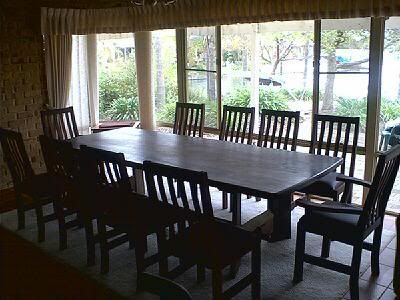

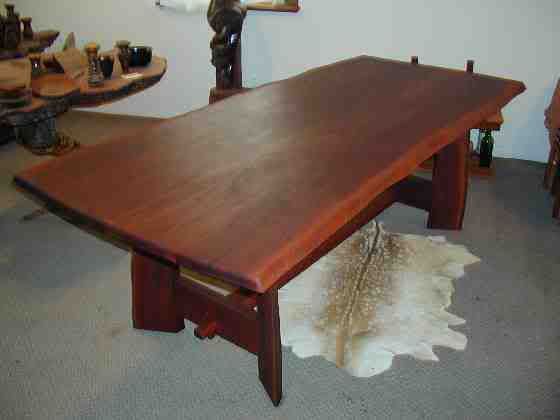
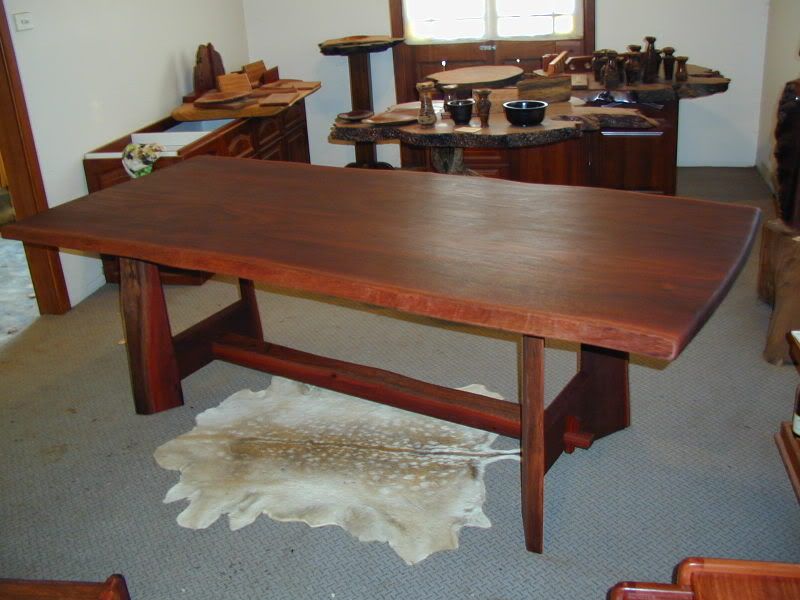
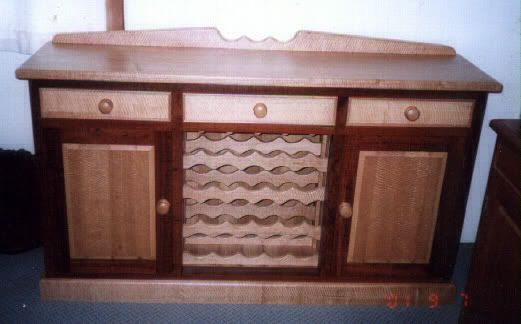
I keep on saying it......
Gillie Stephenson's Orange Oil & bees wax.
It's a reasonable fi9nnish if you don't like the high gloss spray polishes.
I prefer it for its tactile properties (touch, feel, & smell & yes looks).
For some unfathomable reason, natural (wayne) edge tables seem to draw people to run their hands down the natural edge presumably because it's not uniform - it lends itself to exciting the senses, to caress nature with ones hands as it were.
Thus an all natural finish like bees wax over Gillie Stephenson's Orange Oil - seems to leave people with a tactile experience they come away from enjoying.
I still have one of these Jarrah slab tables and chairs suits now and re - oil and wax it around 1 or 2 times a year depending on use & or storage, and i still use the same Gillie Stephensons Orange Oil & Bees wax. It brings me a great deal of enjoyment every time...
It may not be everyone else's cup of tea... but it IS mine.
I get attacked here in the finishing section, pretty much every time I mention it, because it seems I'm the only one using it and others disagree with my methods.
So be it - I still state that it works for me & is all natural and something I've used from furniture to bread and chopping boards for a long time now.
Others are free (or not) - to do whatever floats their boat!
I similarly have probably sprayed enough 20 liter tins of Mirotone spray varnish, to build rafts for 1000 Cuban refugees to sail to Florida and freedom.... and hate the stuff with a passion - but often THAT'S what the client wants and that's what they get.
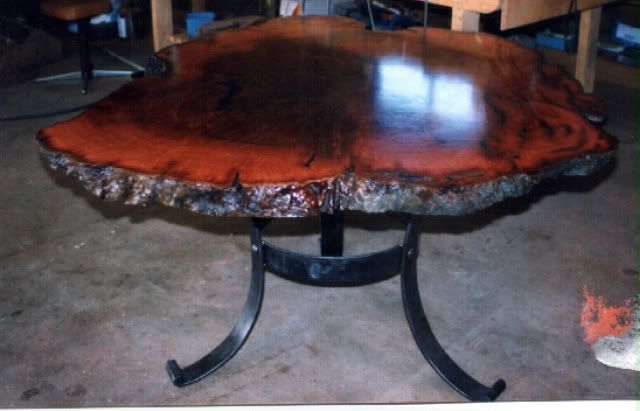
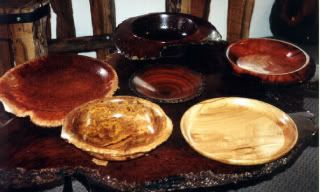
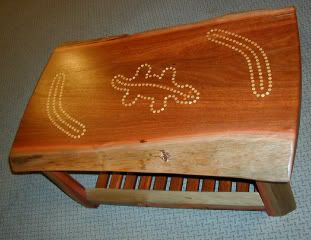
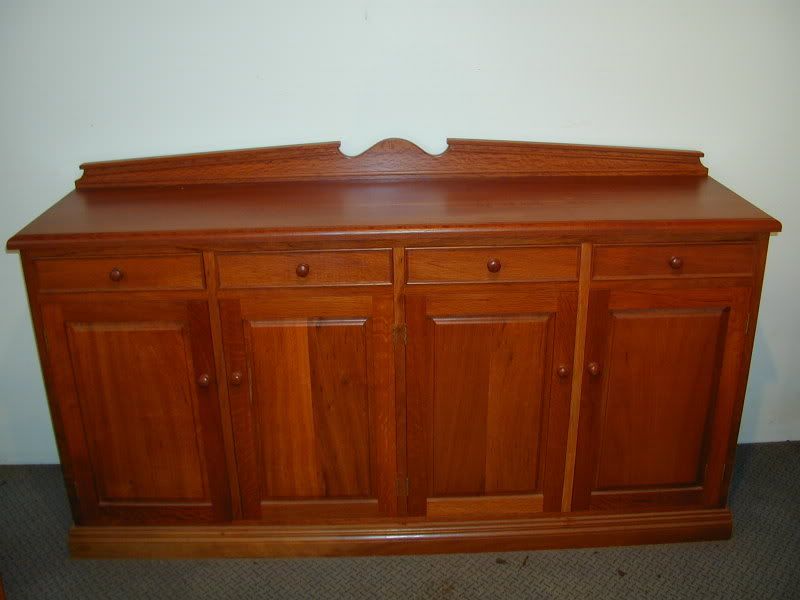
Personally the high build gloss finish spray polishes etc leave me cold.
Its like encasing a all natural timber product in a plastic wrap to isolate it from the human touch, smell & feel... or to plasticize / synthesize it so you can't tell its real wood - to me it sort of defeats the whole purpose of using real wood... (Might as well be chipboard with a photo of wood veneer underneath).
I guess that's my own personal tastes.
Everyone has their own favorite way to finish stuff.
I just happen to like my way.
-
20th December 2013, 07:18 PM #10
 Member
Member











- Join Date
- Jul 2008
- Location
- Banyo Qld
- Age
- 77
- Posts
- 51

Good thing no one actually bagged your finish or finishing methods, otherwise we'd never hear the end of it. It's not all about you, you know. Some people are actually trying to give help and sound advice, whilst you carry on like you've been slighted.
Not trying to be smartarze here but as ubeaut has hinted in his posts and for the sake of the memory of the recently departed GILLY STEVENSON would you please do her the courtesy of spelling her name correctly. It is Gilly (pronounced Jilly) not Gillie pronounced like a fishes gill with a y on the end. Surely as such a fanatical user of the products you would have looked (at least once) at the name on a can or bottle.
Darky Evil to the bone.
Evil to the bone. But really cute.
But really cute. 
-
20th December 2013, 07:29 PM #11
 "I guess that's my own personal tastes.
"I guess that's my own personal tastes.
Everyone has their own favorite way to finish stuff.
I just happen to like my way."
And welcome to it you are.
-
20th December 2013, 08:31 PM #12
 Banned
Banned











- Join Date
- Jul 2013
- Location
- Perth
- Posts
- 665
 Ahh the venom
Ahh the venom
Ahh the venom - can't you just taste it.
Whatever you do don't be right around here (or worse offer good advice to those who seek it) - it upsets the ruling clique no end.
-
20th December 2013, 09:48 PM #13
 Retired
Retired











- Join Date
- May 1999
- Location
- Tooradin,Victoria,Australia
- Age
- 73
- Posts
- 11,918

Play nicely Timless.

Your way may be right for you but not others.
I prefer NC lacquers because I know how to use them and they suit my purpose.
I have also used most of the others as well, it depends on what the customer wants and what the end use is going to be so one finish does not do it all as has been pointed out to you.
In my opinion beeswax is too soft and unless you have scullery maids to strip and rewax every month not a finish for tables that are used.
To answer the original question: Dubbin is formulated for leather and does a great job, but for timber, neigh.
-
23rd December 2013, 05:25 AM #14
 GOLD MEMBER
GOLD MEMBER

- Join Date
- Apr 2011
- Location
- McBride BC Canada
- Posts
- 3,543

Up here in the f-f-f-f-frozen north, I'm working my way through a 400g tin of AerOwax Clear Paste Wax.
Well, son-of-a-gun, it's meant for light colored wooden floors & furniture.
The next couple of carvings in Yellow Cedar will get a dose.
A day later, they will be buffed with a rag wheel in my drill.
I realize that this is an expensive way to go = in years gone by, some Pacific Northwest Native carvers have used various colors of KIWI boot/shoe polish on smaller carvings. Buffed up, there's a satin sheen that's hard to match with anything else.
Dubbin. Why don't you try it? Nobody should say that it is expressly forbidden.
You have lots of it. What are you saving it for?
That would provoke me to do some experiments!
The blurb on the AerOwax tin says:
"For linoleum, light-colored wood floors, terrazzo, wood panelling,
furniture, leather goods."
Similar Threads
-
Finish for green timber
By cultana in forum FINISHINGReplies: 2Last Post: 30th May 2010, 11:47 AM -
outdoor bar top, what timber and/or finish
By Timbre Surfer in forum TIMBERReplies: 0Last Post: 22nd March 2007, 03:07 PM -
What finish won't darken timber?
By quriouskey in forum FINISHINGReplies: 7Last Post: 23rd March 2005, 09:56 PM -
Timber decking finish
By Westy2 in forum FINISHINGReplies: 3Last Post: 22nd January 2005, 12:22 PM -
Timber Finish
By Roly in forum FINISHINGReplies: 3Last Post: 14th November 2001, 01:02 PM



 Likes:
Likes: 
 Reply With Quote
Reply With Quote

